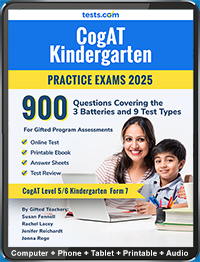The CogAT Test Guide
| CogAT Test Summary
|
|
|---|---|
| What: The CogAt is a test to evaluate student's general reasoning capabilities. | |
| Who: The test is for students in grades K-12. | |
| Where: Tests are administered in school for students K-12. | |
| When: The test is offered at the school's discretion throughout the year. | |
| How: Students are asked to solve numeric and geometric puzzles as well as verbal exercises such as logically completing sentences. | |
| Type: Paper and pencil. | |
| Why: The exam is used to place students in gifted programs. | |
| Time: The test takes 145 minutes for students in grades 3-12, 138 minutes for students in grades 1-2 and 169 minutes for students in kindergarten. | |
| Language: English | |
| Preparation: Students can prepare by taking practice tests and performing practice problems. | |
| Cost: No cost. | |
by Giles Howard, Tests.com
The Cognitive Abilities Test (CogAt) is an evaluation of a student’s verbal, quantitative and non-verbal reasoning skills. Administered to grades K-12, the CogAt is designed as an assessment of pure reasoning skills used to identify gifted students. The test series is developed by Riverside Publishing and has been published since 1954.
CogAt Format
The CogAt is made up of three batteries of tests, each of which consists of two or three subsections that take between 10 and 24 minutes to complete. There are two versions of the CogAt: the Primary Edition tests students in grades K-2 and the Multilevel Edition tests students in grades 3-12.
CogAt Sections
The first battery of the CogAt is the verbal battery. This group of tests evaluates students' verbal memory, vocabulary and comprehension of word relationships. The verbal battery is broken down into a number of subsections based on the age of the student:
K-2
- Oral Vocabulary
- Verbal Reasoning
3-12
- Verbal Classification
- Sentence Completion
- Verbal Analogies
The second battery of the CogAt is the quantitative battery. This group of tests evaluates students' skill level in problem solving and quantitative reasoning. Like the verbal battery, the quantitative battery is broken down into subsections based on the student's age:
K-2
- Relational Concepts
- Quantitative Concepts
3-12
- Number Series
- Equation Building
- Quantitative Relationships
The final test battery is the nonverbal battery that tests students' problem solving ability. It consists of a number of nonverbal problems involving geometric shapes and puzzles. Because this test battery involves no reading, it is an ideal set of tests to evaluate students with low English proficiency or students who have difficulty reading. It is broken down into subsections based on a student's age:
K-2
- Figure Classification
- Matrices
3-12
- Figure Classification
- Figure Analysis
- Figure Analogies
- Test Preparation
It's possible to prepare for reasoning tests such as the CogAt by taking practice tests and performing practice problems. These practice exams and problems familiarize students with the format of the test and the types of questions that will be on it. Because the test does not evaluate any sort of subject comprehension, it is unnecessary to study any vocabulary, math or science in preparing for the CogAt.
To find test preparation materials, please visit our CogAT Directory. To learn more about the CogAT, read our interview with CogAT expert Tim Sitar.
Sources: Riverpub.com, Issaquah.wednet.edu





